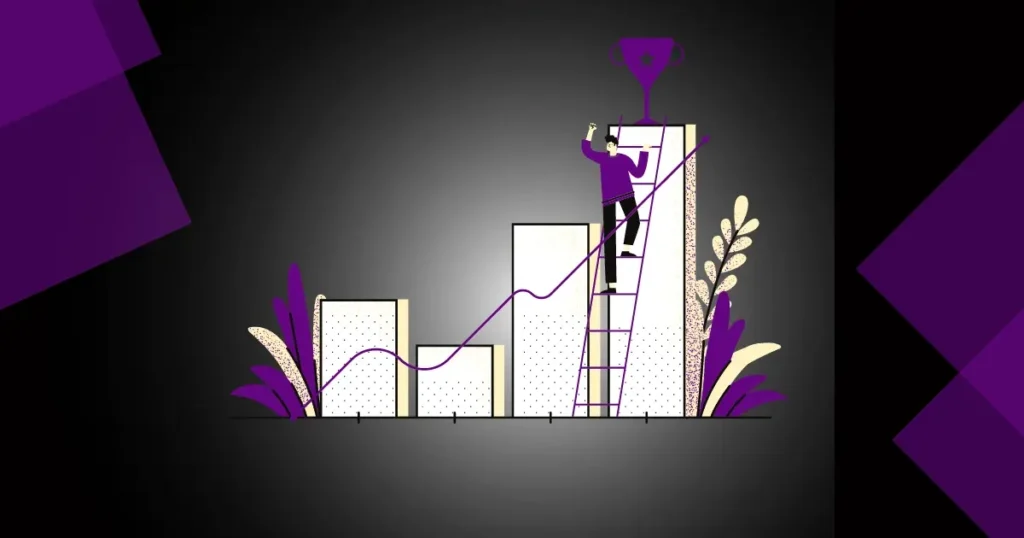
Are you looking to create a profitable SaaS MVP to scale your business? You’ve come to the right place! Developing a SaaS MVP is a vital step for businesses aiming to scale and stand out in the competitive tech landscape.
MVP SaaS development can be a game-changer for startups who have minimal resources and time. This approach helps you to launch your product quickly and effectively.
With the SaaS market projected to reach $1,057.8 billion by 2032, there’s never been a better time to get started.
While building a SaaS MVP can be challenging and requires significant time and effort, don’t worry!
In this blog, we’ve compiled all the essential information to guide you through the process of creating your SaaS MVP.
What is a SaaS MVP?
SaaS MVP is a simplified version of the product with enough features you should use to verify your concept and collect feedback from customers. It is different from a full version of the product and a way to attract early adopter customers and validate the product idea.
The global SaaS market is expected to grow from $131 billion in 2018 to $270 billion by 2026.
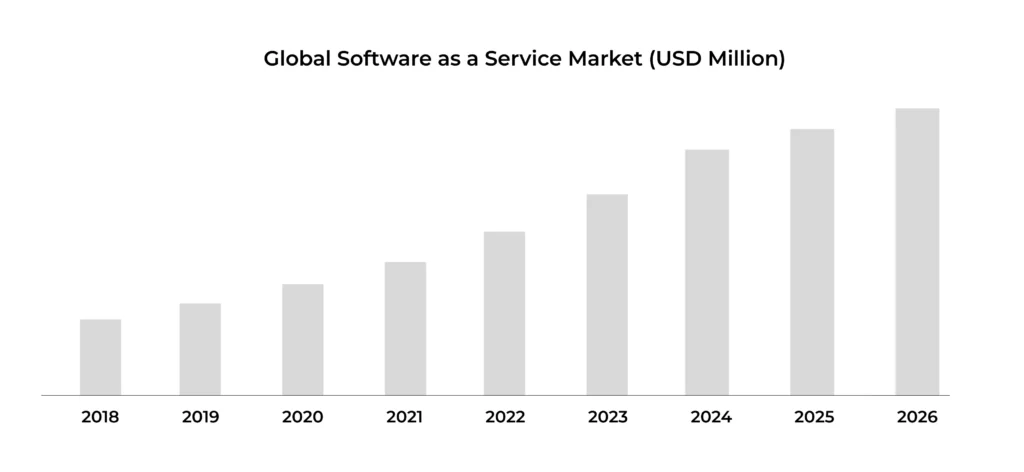
The main purpose of building the SaaS MVP is to:
- Reduce the development cost and time
- Rapidly launch your product
- Help you get funds from investors for your SaaS product
Moreover, it provides a roadmap from idea to launch, giving you the essential tools to design, develop, and deploy a minimum viable product. It ensures that your MVP not only fulfills your initial needs but also establishes a solid groundwork for future scalability and improvements.
How to Build the SaaS MVP in 7 Steps?
Building a large SaaS platform is costly. Starting your product with MVP is a proven way to validate your idea.
Here are some steps to help you build the SaaS MVP.
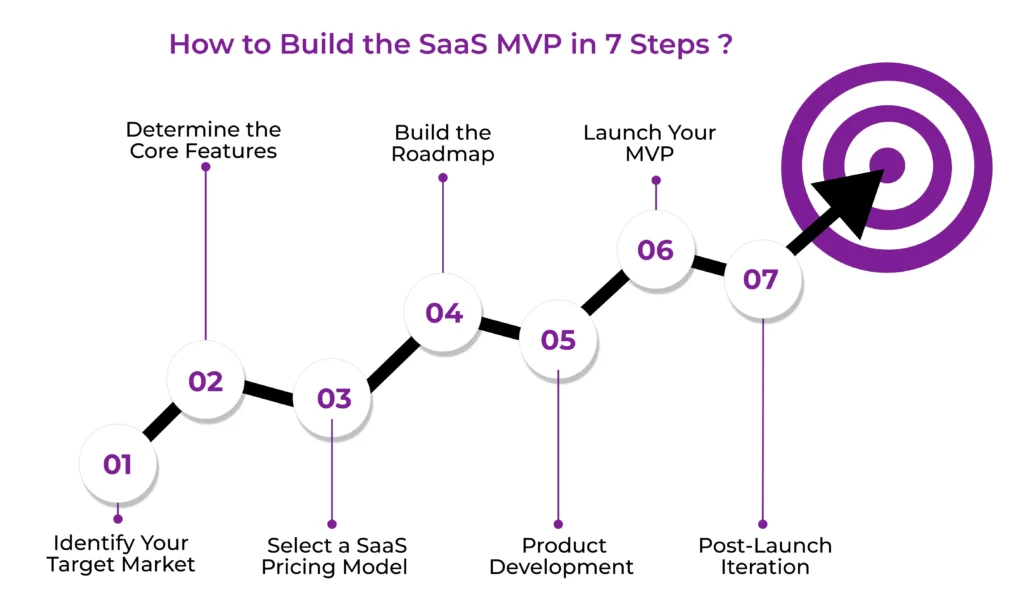
1. Identify Your Target Market
This is the first step in SaaS MVP development. Competitive research helps to understand whether your SaaS idea is worth implementing. This step sets the foundation for your MVP.
In this step, you have to gather this information:
- Identify your target market and understand who your SaaS product is and what needs and pain points they have.
- Understand your customer’s needs, preferences, and pain points.
- Know about your direct and indirect competitors. Study what has already been done in the market, and spot gaps and mistakes.
- Know different pricing models.
- Determine the current situation and solutions in the market.
Using this information, you know whether your idea for a project is worth it or not. The result of this research will form the backbone of your many decisions.
Moreover, from your gathered information, you can define functional and non-functional requirements and identify your unique value proposition.
Launch Your SaaS Product with NinjasCode
2. Determine the Core Features of Your SaaS Product
It is a vital step in building the MVP. In this step, you have to identify the main features of your SaaS product.
Many companies make big mistakes and stuff their SaaS MVP with non-essential features and make them too complex. You have to understand that it is not an end-product, so focus on essential features that are needed to test your product viability.
The prioritization technique is a valuable method for selecting features, especially in product development.
Here are some effective strategies within this technique.
MoSCoW Method
- Must have: Essential features needed for the product to be functional.
- Should have: Important but not critical features.
- Could have: Nice-to-have features that can be included if time allows.
- Won’t have: Features that are not prioritized for this iteration.
Kano Model
- Categorize features into:
- Basic Needs: Features that users expect.
- Performance Needs: Features that improve satisfaction as they are enhanced.
- Delighters: Features that can surprise users and exceed their expectations.
Weighted Scoring
- List features and assign weights based on criteria such as user value, cost, development time, and alignment with business goals. Calculate a score for each feature to prioritize them.
Value vs. Effort Matrix
- Plot features on a matrix based on the value they provide versus the effort required to implement them. This helps in identifying quick wins and high-value features.
User Feedback and Testing
- Gather insights from users through surveys, interviews, or usability tests to understand their needs and preferences, which can guide feature prioritization.
Stakeholder Input
- Involve key stakeholders to gather perspectives on which features are most important for the business and its goals.
3. Select a SaaS Pricing Model
In this step, you have to decide on the SaaS pricing model. Choose it carefully that meets your business needs. There are different pricing models available, such as:
Freemium Model: In this model, you offer a SaaS product for free with the option to upgrade to a paid version. Using this model, you can attract early adopters to start using your MVP.
79% of SaaS companies that offer a free trial or freemium product get in touch with customers during the first month of the trial period.
Tiered Pricing: This is a popular SaaS pricing model. In this model, you can offer different levels of service at different pricing points such as a basic, standard, and premium plan. However, each plan has different features.
Usage-based Pricing: It is another popular type of SaaS pricing. The usage-based pricing is when you charge customers based on their usage of your SaaS product.
4. Build the Product Roadmap
The roadmap shows the major steps of product development. It makes your development process hassle-free. Therefore, before starting the development process, create a document that includes all the project requirements to help designers and developers.
In this document, you should include these things:
- Functional and non-functional requirements
- Features you want to include in your MVP and prioritize them on importance
- Design specifications
- Timeline of your SaaS product
- Short-term and long-term goals
5. Product Development
Once you build the roadmap, it’s time to start developing SaaS MVP. It involves turning your ideas and plans into a functional product.
In this step, you have to follow these steps.
- Select appropriate frameworks, libraries, and languages that suit your product’s requirements (e.g., React, Node.js).
- Create wireframes and prototypes to visualize the overall layout. Sketch the layout of your application, focusing on functionality and navigation.
- Develop clickable prototypes to simulate the user journey, allowing for user testing and feedback.
- Develop the user interface and ensure it is responsive and intuitive.
- Build a robust backend architecture that supports your SaaS application.
- Choose the right database (SQL or NoSQL) and design a schema that aligns with your data needs.
- Conduct thorough testing to ensure functionality, performance, and security.
Moreover, you can develop your MVP using no-code SaaS tools. They help companies build an MVP with limited resources, and technical expertise and launch it without extensive coding or development skills.
The below table shows the differences between code base and no-code MVP development to help you make a better decision.
| Code-Base MVP Development | No-Code MVP Development |
| Coding skills are required | No coding required |
| Create complex apps | Create simple apps |
| Customization available | Pre-build templates available |
| Cost-effective for companies who have developers | Cost-effective for companies who don’t have developers |
6. Launch Your MVP
Once everything is in place, launch your MVP to a selected audience. Promote your MVP development services through various channels (social media, email campaigns, etc.) to attract initial users. Establish a process for gathering user feedback to inform future iterations and improvements.
7. Post-Launch Iteration
After launching, continue to gather feedback on your product. Use interviews, surveys, and analytics to understand user preferences and behavior. Prioritize enhancements based on user input and market needs.
Benefits of Building a SaaS MVP
Below are some benefits that you get from building a SaaS MVP.
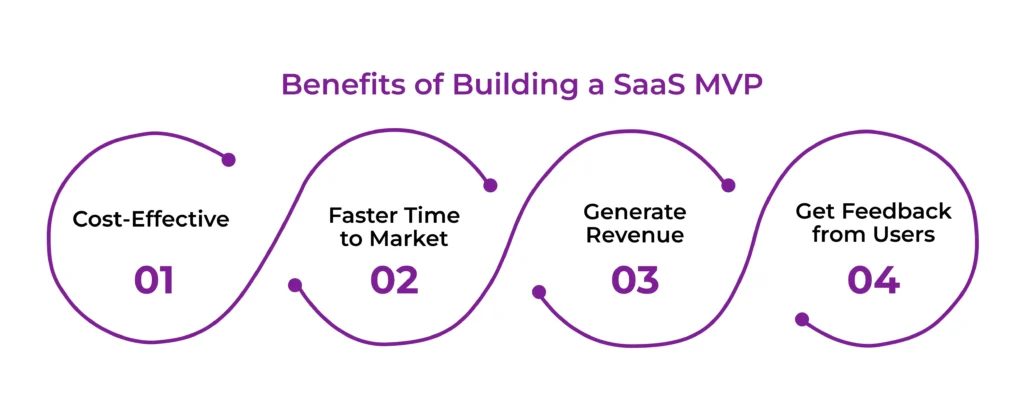
Cost-Effective
Building the SaaS MVP is a cost-effective way to launch your product in the market. It is well-suited for startups because of limited resources, they can validate their product idea with essential features.
In addition, SaaS MVP can be built faster and at a lower cost than full-fledged software. You can add advanced features to your SaaS platform in the future as it expands.
Faster Time to Market
It is one of the success factors for SaaS MVP. By concentrating on core features that address the primary needs of your target audience, you can manage the product development lifecycle. This allows you to quickly launch your product and establish a presence in the market, which is essential for gaining a competitive edge.
Generate Revenue
Launching an MVP creates an opportunity to start generating revenue early. By offering a product that meets immediate user needs, you can attract paying customers and begin monetizing your solution. Early revenue generation can provide the necessary funding for further development and enhancement of your product.
Get Feedback from Users
Once your MVP is in the market, gather feedback from users. This feedback will help you understand how your product is being used, what additional features users might want, and what pain points they experience.
How Much Does a Saas MVP Cost?
The below table shows the costs associated with building a SaaS MVP.
| Cost Component | Description | Estimated Cost Range |
| Market Research | Analyzing target users and competitors | $1,000 – $5,000 |
| Design | UI/UX design for the product interface | $2,000 – $10,000 |
| Development | Backend and frontend development | $10,000 – $50,000 |
| Testing | Quality assurance and user testing | $1,000 – $5,000 |
| Project Management | Coordination and management of the project | $1,000 – $5,000 |
| Hosting/Infrastructure | Initial server setup and hosting costs | $500 – $2,000 |
| Marketing | Basic promotional efforts to attract early users | $1,000 – $5,000 |
| Miscellaneous | Legal fees, tools, and other expenses | $500 – $2,000 |
| Total Estimated Cost: $17,000 – $84,000 | ||
The costs can vary based on factors such as:
- Location: Costs can vary greatly based on geographic location (e.g., hiring developers in different countries).
- Complexity: More complex features or integrations will increase development costs.
- Iterative Process: MVP development is often iterative, allowing for adjustments based on user feedback which can affect overall costs.
Challenges of Building the SaaS MVP
Building a SaaS MVP provides benefits, but it also comes with challenges, such as:
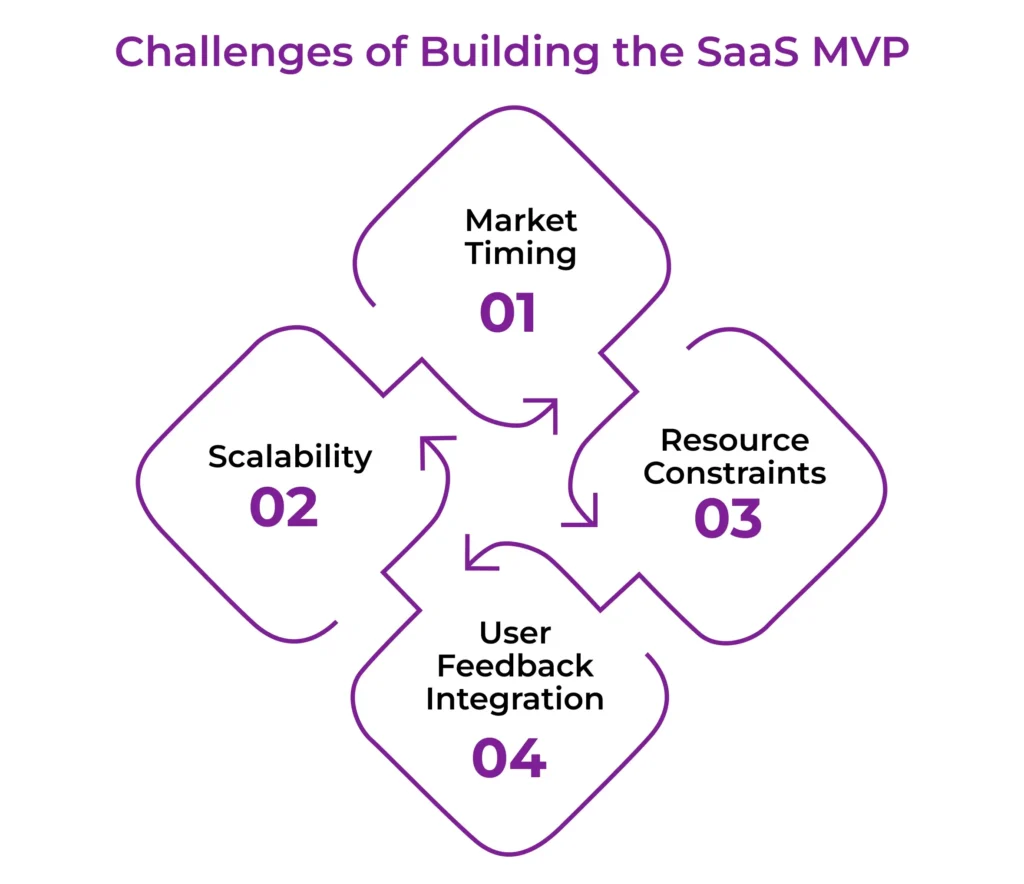
Scalability
- Challenge: If the initial architecture of the SaaS MVP is not designed with scalability in mind, it can become difficult to handle increased user loads and data as the product grows.
- Solution: Invest time in designing a scalable architecture from the start. Using cloud services that allow for easy scaling, such as AWS, Azure, or Google Cloud.
Market Timing
- Challenge: Launching at the wrong time can lead to failure, whether it’s too early when the market isn’t ready or too late when competition is strong.
- Solution: Conduct thorough market research to understand trends and customer needs, allowing for a more strategic launch.
Resource Constraints
- Challenge: Startups often operate with limited budgets and manpower, which can hinder development and marketing efforts.
- Solution: Prioritize features based on user feedback and market demand, and consider outsourcing certain tasks to maximize efficiency.
User Feedback Integration
- Challenge: Gathering and effectively integrating user feedback into the product can be challenging, especially if the feedback is conflicting or unclear.
- Solution: Use structured feedback mechanisms, such as surveys and user interviews, to gather actionable insights and prioritize them based on impact.
Tips for Building the SaaS MVP
Here are some tips to help you successfully build a SaaS MVP.
- Do in-depth research and gather all the information to help you identify your competitor’s weaknesses and strengths.
- Focus on generating customer interest in your SaaS MVP and gathering feedback.
- Instead of adding the features in your MVP, prioritize them.
- Test different pricing models and choose the one that best fits your business needs.
- Understand customer pain points before starting product development.
- Keep the MVP development cost in mind and keep track of all the expenses.
- Collect feedback on your MVP and refine its functionality based on user demands.
- Eliminate unnecessary features from your MVP.
Conclusion
Building the SaaS MVP is the best way to bring your product vision to reality with profitable revenue. It has gained significant popularity due to its accessibility and cost-effectiveness. Therefore, building it can help you stay in the competitive market.
By the end of 2024, it is expected that 99% of companies will use at least one SaaS solution.
If you want to build a SaaS MVP for your business, contact NinjasCode. Our developers can develop an MVP that meets the unique needs of your business. Whether you need a custom software solution or a SaaS web/app, our experts will help you in achieving your business objective.
So, schedule a meeting with us and get the MVP that help you succeed.
FAQs
- How long does it take to build a SaaS MVP?
MVP takes 3-6 months to build it. However, the time varies and depends on your product requirements.
- What is the best approach to building an MVP?
The best approach to building an MVP involves identifying the core problem your product addresses and defining the essential features that solve this problem. Focus on rapid prototyping and iterating based on user feedback. Prioritize simplicity and usability to validate your concept while minimizing development time and costs.
- What is an MVP example?
An example of an MVP is Dropbox’s early version, which consisted of a simple video demo showcasing its file-sharing capabilities, allowing them to measure user interest before developing the full product.







